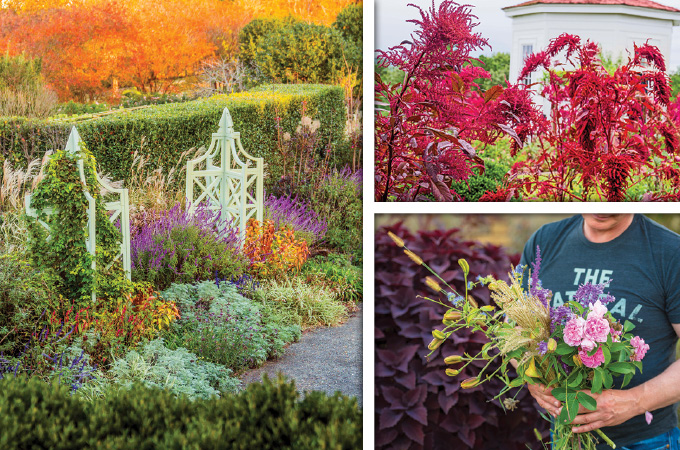The first signs of autumn bring a certain sigh of relief as the garden season comes to a close. Over time, I have learned to accept the season and relax. I can finally let the garden go. Week by week, I do less and observe more.
This allows me more time to be in the moment and enjoy the beauty and vibrancy of the garden or even just a single bloom. Though the plants are slowly nodding off to sleep, it’s one of the most dynamic times of the year. It’s as though nature knows that winter is nigh, and she puts forth that last extra push to bring us more vivid colors, seeds, fruit and unprecedented animation from our pollinator friends. It’s the final show, and every player is dressed accordingly.
The later in the season, the more exuberant my hyacinth bean vines become. (If you’ve never grown this annual vine, put it on your list.) More blooms and more luxurious burgundy-purple seed pods appear. The balance of bloom to pods to foliage reaches a magical harmony that provokes constant comments from our visitors. Even the purple of the leaves and stems deepens as the night temperatures fall. By late autumn, I gather seed pods for the following year and hang them in our octagonal drying houses. Saving seed is a joy in itself, a deliberate act of perpetuating the next generation with hope and anticipation of the next season.
Other annuals that are in full swing are late crops of zinnias (I love the apricot-colored ones) and celosia. These are both members of the majestic cockscomb family that produce those otherworldly, velveteen blooms so good for drying. Late sunflowers, too, add height and a statuesque quality among the vegetable garden, randomly towering over other members of the cast. My favorite sunflowers for cutting are ‘Vincent Clear’ and ‘Vincent’s Choice.’ Blooms last up to 10 days in the vase.
Oddities with a special brand of beauty require patience for an end-of-the-season crescendo, such as the castor bean plant. Although the beans are considered poisonous, the red, prickly looking blooms are spectacular. They are supported by plants that grow fast and add depth through their course texture and reddish foliage. ‘Carmencita’ has become a favorite cultivar of mine for its more intense color, both with bloom and foliage. If you love the color red, you should also consider ‘Polish Spirit’ amaranth, equally showy, grown from seed and completely edible unlike ‘Carmencita.’
The list goes on with other annuals such as SunPatiens, probably at their best moments of flower power now and with a huge range of color. These plants press on with generous, unending blooms despite blooming all summer long. The full sun-loving impatiens hybrid has genetics that can withstand the hottest days of summer and still look fresh and enthusiastic when fall begins.
Perennials play their role, too. The Russian sage (Perovskia) is back in full bloom again after cutting the plants back to half their size in late July. The salvias are at their best: ‘Black and Blue,’ ‘Mystic Spires’ and ‘Mexican Sage’ are showstoppers, along with goldenrod ‘Fireworks.’ Cannas and some Lantana varieties have proven to be cold-hardy for our Zone 8b garden at Moss Mountain Farm. These join the chorus with gusto, almost desperate for attention.
This cacophony of blooms makes for an enticing ecosystem for our pollinators. I call it a ‘fantastacology,’ given we’ve amplified what our pollinators might find in nature by intensely and purposefully planting plenty of species that provide food and a habitat. Many are on their way to distant places (such as the Monarch butterflies) and need a place to stop, rest and refuel. We are only too happy to show them some hospitality and encourage them to linger.
I encourage you to visit Moss Mountain Farm this fall to experience this rich and colorful season. With temperatures dropping and leaves falling, it’s one of the best times of year to take a relaxing stroll through the garden and witness the final show of the season.
P. Allen Smith is an author, conservationist and TV host of Garden Home on PBS and Garden Style (check your local listings). He uses his Arkansas home, Moss Mountain Farm, to promote the local food movement, organic gardening and the preservation of heritage poultry. For tours of the farm, visit pallensmith.com/tours.
Photos: Mark Fonville
